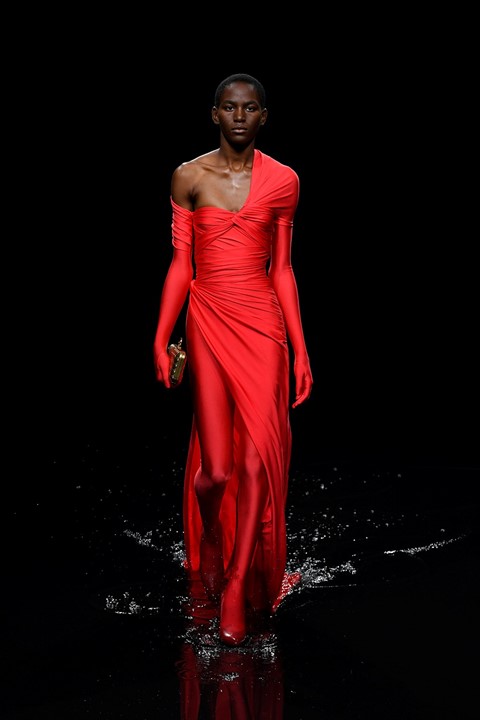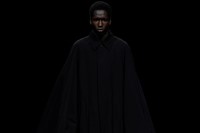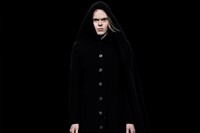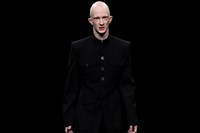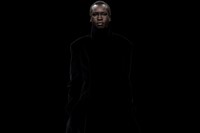Presented on a flooded catwalk, Demna Gvasalia’s Autumn/Winter 2020 collection for Balenciaga conjured the end of days with a wardrobe both sacred and profane
A sense of impending doom hovered over Demna Gvasalia’s latest show for Balenciaga, held at La Cité du Cinéma film studios on the outskirts of Paris this past weekend. Guests arrived in almost complete darkness; as the lights rose, a flooded catwalk appeared – around which the stadium-style bleachers were half-submerged. Above the runway, a vast LED-lit ceiling conjured stormy skies and burning flames, eventually zooming out to reveal the earth as if looking down upon it from outer space. The mood was apocalyptic; backstage, Gvasalia noted he had scented the room with kerosene. Was this a designer ready to burn it all to the ground?
Out into this combustible abyss Gvasalia’s protagonists strode, oil-black water lapping at their ankles. They wore black, too: a stream of capes, hoods, robes, and gowns, cut with monastic austerity. They had emerged from the designer’s memories of attending the Eastern Orthodox Church as a child in Georgia, where the traditional institution continues to wield considerable influence. Cristóbal Balenciaga was fascinated by the church, too: a practising Catholic throughout his life, his own creations were informed by the rich and ritualistic dress codes of the Spanish clergy and the lavish draperies of Francisco de Zurbarán’s paintings of monks, nuns and martyrs.
Gvasalia began with a high-necked dress, in black velvet, reminiscent of a priest’s cassock. Gvasalia noted that several of Cristóbal Balenciaga’s very first designs were made from black velvet, designed for women to wear to church (he has purportedly been spending more time in the archive than ever, in preparation for his debut haute couture show this June). The next looks followed a similarly austere, monastic line, from billowing trench coats – cut at the back like a mantle – to various iterations of the cassock or nun’s habit, via a series of chaste floor-length outerwear and gowns (on one, in place of the clerical collar, the white double-B Balenciaga logo and monogram).
If Cristóbal Balenciaga was propelled by the sincerity of his belief, Gvasalia likes to meld the sacred with the profane (one memorable show for Vetements, the brand he founded and has since departed, was held in a Parisian church and saw models in school-girl mini skirts, thigh-high leather boots and T-shirts reading ‘Sexual Fantasies’ and ‘You Fuck’n Asshole’ stride down the central aisle). Here, he imbued the priest with a frisson of teenage sex appeal. “I went to church every Saturday,” Gvasalia said. “I remember looking at all these young priests and monks, wearing these long robes and thinking, ‘How beautiful’. You see them around Europe with their beards, hair knotted back and backpacks ... I find it quite hot, but that’s my fetish.”
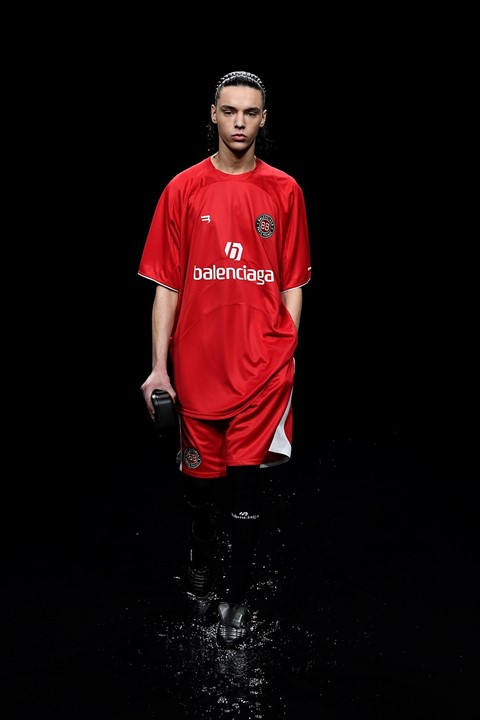
It set him to thinking about rituals and pleasure; religious sects and the societal groups which feel like them. There were footballers – or perhaps football fans – in Balenciaga-branded kit and thigh-high socks (footballers were another fetish, he said); the “new gothics” in swamping leather jackets and spiked rubber; moto-cross racers in full biker garb; power-shouldered corporate execs (here, his signature pitched shoulders took on new heights); water-sporters in top-to-bottom neoprene, all the way down to the toes (a collaboration with Vibram and their notorious ‘FiveFingers’ shoes). It ended with evening-wear: floor-length gowns in glittering crystal or shimmering black pailettes, or twisting lycra creations which were entirely one-piece, from glove to shoe. Because if it’s the end of days, why not go out in style?
Then, it all went black. The show left a lingering question: what next? “In spite of all that’s going on in fashion and the world, I still love this,” Gvasalia assured backstage. “I suppose until the day I die, this is what I am passionate about. I love making clothes.”
